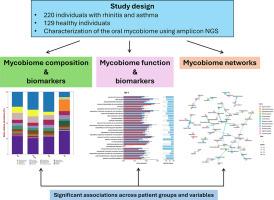葡萄牙过敏性鼻炎和哮喘患者的口腔真菌生物群特征
IF 4.8
Q1 MICROBIOLOGY
引用次数: 0
摘要
过敏性鼻炎和哮喘是两种常见的慢性气道疾病,也是严重的公共卫生问题。以前的研究已经描述了气道细菌组在这两种疾病中的作用,但迄今为止几乎还没有研究探讨过霉菌生物组及其与气道炎症的可能关联。在这里,我们对内部转录间隔(ITS)1 和 2 进行了测序,以描述 349 名患有单纯过敏性鼻炎(AR)或哮喘(ARAS)、哮喘患者(AS)和健康对照组(HC)的葡萄牙儿童和年轻人的口腔真菌生物群的特征。我们的基因组分析表明,口腔中含量最高的两个真菌门(子囊菌门和担子菌门)和 14 个含量最高的真菌属(Cladosporium、Aspergillus、Aleurina、Candida 和 Rhodotorula)中的 3-5 个(Cladosporium、Aspergillus、Aleurina、Candida 和 Rhodotorula)在鼻炎组和健康对照组之间存在显著差异(P ≤ 0.04)。然而,在三个呼吸道疾病组(AR、ARAS 和 AS)之间,相同的类群均无明显差异。呼吸道疾病患者的口腔真菌生物群显示出最高的组内多样性(微生物丰富度和均匀度),而 HC 显示出最低的组内多样性,它们之间的所有α-多样性指数均有显著差异(P ≤ 0.0424)。同样,与 HC 样品相比,所有疾病组的微生物结构(即贝塔多样性指数)都有显著差异(P ≤ 0.0052)。AR或ARAS患者与HC患者之间有30种代谢途径(PICRUSt2)的含量存在差异(沃尔德检验),但其中只有一种途径(D-半乳糖降解I)在ARAS组中含量过高(log2折叠变化>0.75)。各组之间的 Spiec-Easi 真菌网络差异很大,这表明慢性呼吸道过敏性疾病可能会改变口腔中的真菌连通性。这项研究加深了我们对口腔真菌生物群在过敏相关疾病中的作用的理解。它首次显示了口腔真菌生物群在健康和过敏性鼻炎(合并或不合并哮喘)期间的变化,并强调了可能与慢性气道疾病相关的特定类群、代谢途径和真菌相互作用。本文章由计算机程序翻译,如有差异,请以英文原文为准。

Characterization of the oral mycobiome of Portuguese with allergic rhinitis and asthma
Allergic rhinitis and asthma are two prevailing chronic airway diseases and serious public health concerns. Previous research has already described the role of the airway bacteriome in these two diseases, but almost no study so far has explored the mycobiome and its possible association to airway inflammation. Here we sequenced the internal transcribed spacers (ITS) 1 and 2 to characterize the oral mycobiome of 349 Portuguese children and young adults with allergic rhinitis alone (AR) or with asthma (ARAS), asthmatics (AS) and healthy controls (HC). Our genomic analyses showed that the two most abundant fungal phyla (Ascomycota and Basidiomycota) and 3–5 of the 14 most abundant fungal genera (Cladosporium, Aspergillus, Aleurina, Candida and Rhodotorula) in the mouth differed significantly (P ≤ 0.04) between both rhinitic groups and HC. However, none of the same taxa varied significantly between the three respiratory disease groups (AR, ARAS and AS). The oral mycobiomes of respiratory ill patients showed the highest intra-group diversity (microbial richness and evenness), while HC showed the lowest, with all alpha-diversity indices varying significantly (P ≤ 0.0424) between them. Similarly, all disease groups showed significant differences (P ≤ 0.0052) in microbial structure (i.e., beta-diversity indices) when compared to HC samples. Thirty metabolic pathways (PICRUSt2) were differentially abundant (Wald's test) between AR or ARAS and HC patients, but only one of them (D-galactose degradation I) was over abundant (log2 Fold Change >0.75) in the ARAS group. Spiec-Easi fungal networks varied greatly among groups, which suggests chronic respiratory allergic diseases may alter fungal connectivity in the mouth. This study increases our comprehension of the role of the oral mycobiome in allergy-related conditions. It shows for the first time that the oral mycobiota changes during health and allergic rhinitis (with and without asthma comorbidity) and highlights specific taxa, metabolic pathways and fungal interactions that may relate to chronic airway disease.
求助全文
通过发布文献求助,成功后即可免费获取论文全文。
去求助
来源期刊

Current Research in Microbial Sciences
Immunology and Microbiology-Immunology and Microbiology (miscellaneous)
CiteScore
7.90
自引率
0.00%
发文量
81
审稿时长
66 days
 求助内容:
求助内容: 应助结果提醒方式:
应助结果提醒方式:


